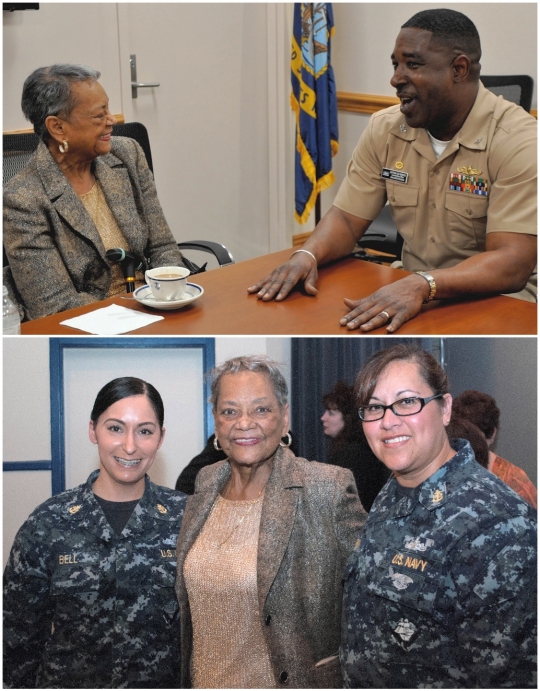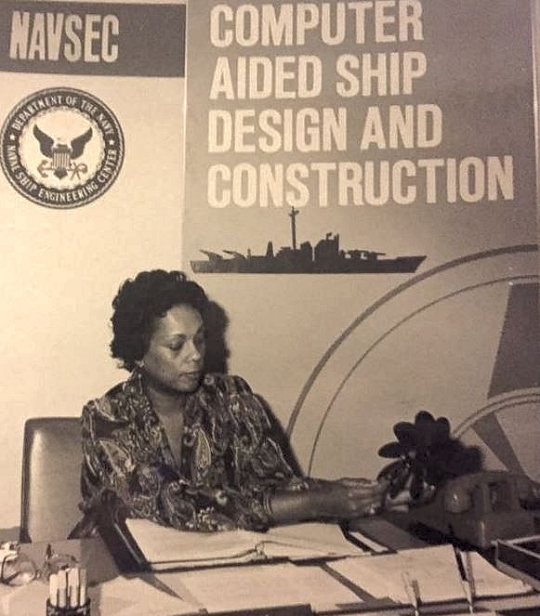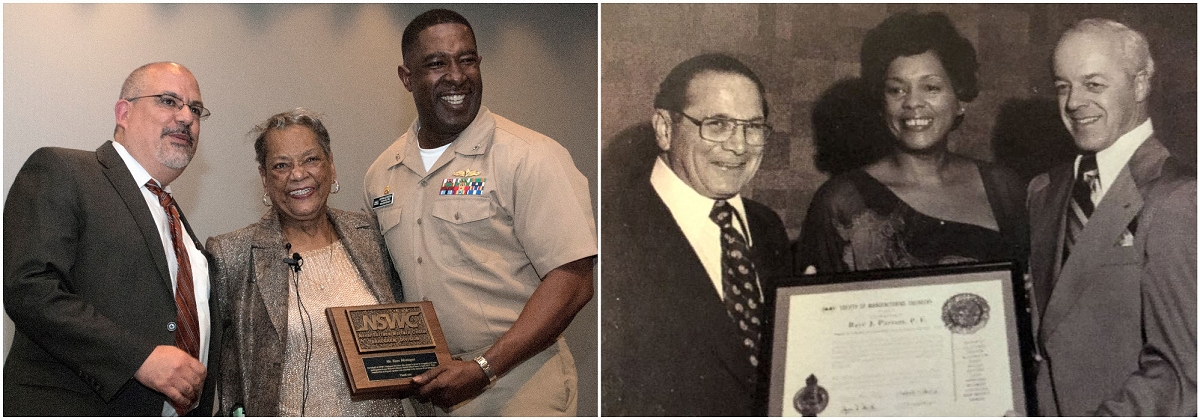 Top photo: DAHLGREN, Va. (April 4, 2017) - The Navy's 'hidden figure' Raye Montague and Naval Surface Warfare Center Dahlgren Division (NSWCDD) Commanding Officer Capt. Godfrey 'Gus' Weekes meet at NSWCDD headquarters prior to Montague's keynote speech at a National Women's History Month Observance. Montague was the first person to design a U.S. Navy ship - the USS Oliver Hazard Perry (FFG-7) - using a computer, revolutionizing naval ship design. (U.S. Navy Photo by John Joyce/Released)
Top photo: DAHLGREN, Va. (April 4, 2017) - The Navy's 'hidden figure' Raye Montague and Naval Surface Warfare Center Dahlgren Division (NSWCDD) Commanding Officer Capt. Godfrey 'Gus' Weekes meet at NSWCDD headquarters prior to Montague's keynote speech at a National Women's History Month Observance. Montague was the first person to design a U.S. Navy ship - the USS Oliver Hazard Perry (FFG-7) - using a computer, revolutionizing naval ship design. (U.S. Navy Photo by John Joyce/Released)
Bottom photo: DAHLGREN, Va. (April 4, 2017) - Navy Chief Petty Officers are pictured with retired Navy engineer Raye Montague after her keynote speech at a Women's History Month Observance held at Naval Support Activity South Potomac, comprising bases at Indian Head, Md., and Dahlgren. Montague was the first person to design a U.S. Navy ship - the USS Oliver Hazard Perry (FFG-7) - using a computer, revolutionizing naval ship design. The Navy's "hidden figure" spoke about her life and career experiences, sharing her words of wisdom to all gathered at the base theater to celebrate the observance. (U.S. Navy Photo by Bill Tremper/Released)
DAHLGREN, Va. (April, 2017)—It was the first time Raye Montague traveled by train since 1956 when she left segregated Little Rock, Arkansas, to look for a job in Washington D.C.
The Navy's first woman engineer was on her way to speak at a Women's History Month event sponsored by the Naval Surface Warfare Center Dahlgren Division (NSWCDD), April 4.
As the train headed toward Virginia, Montague reflected on her life, career experiences, and any words of wisdom, that she could pass on to those gathered at the Naval Support Facility theater to celebrate an observance emphasizing the 2017 Women's History national theme: "Honoring Trailblazing Women in Labor and Business."
Montague didn't know where she would work—let alone foresee that she would become a trailblazer in labor, business, government, military, and academia—when she arrived in the nation's capital 61 years ago.
"I really didn't know what I was going to do," Montague told the military, government civilian, and defense contractor audience. "What am I going to do? What type of job am I going to be able to get? How am I going to make a living? All of a sudden, I'm on my own."
At the time, the Navy's first woman program manager for ships knew she would become an engineer. The fact that she did not have an engineering degree did not stop her dream from becoming reality.
"I made that decision when I was seven years-old," said Montague, recounting a pivotal moment in her life. The United States captured a German mini-submarine off the Carolinas and brought it to downtown Little Rock, and my grandfather took me down to see it. I saw the dials and mechanisms and looked through the periscope."
Montague asked the tour guide what she needed to know to operate a submarine, and recalled his response, "Oh, you'd have to be an engineer but you don't ever have to worry about that."
"Well, I didn't realize that I had been insulted because of my gender and my race," said Montague. She asked her mother to find out what was required to be an engineer and found that "it was math and science and thinking outside of the box."
Montague's mother, as well as her eighth grade teacher, encouraged her to dream big and think out of the box, she said.
"Aim for the stars, at the very worst, you'll land on the moon," said Montague repeating her teacher's advice.
Throughout her life, Montague recalled she remained undaunted and overcame objections, cultural challenges, and she didn't just break glass ceilings, she refused to acknowledge them.
For example, Montague's high school required four years of home economics for girls but she wanted to build design things in shop class.
"Girls couldn't go to shop," said Montague, but her mother "did battle" with school administrators, "and convinced them that if I could pass the written exam in home economics without attending the classes, I could take shop. What they didn't realize was that I had a photographic memory."
Montague aced the home economics classes and took four years of high school shop classes.
"After I graduated high school, I wanted to go to engineering school," she said; however, "the only school in the state of Arkansas that offered a degree in engineering was the University of Arkansas in Fayetteville and they did not accept minorities."
The Arkansas Agricultural, Mechanical and Normal College accepted Montague who graduated with a bachelor of science degree in business at the historically black college and university. "In the meantime, I was in the debate teams in high school and in college so I could hold my own in speaking," she said.
Montague would use her speaking skills to great advantage in her remarkable 33-year career with the U.S. Navy.
One day after graduation, she took the train to Washington D.C. with plans to learn more about engineering and take charge of her career.
The Navy hired her as a GS-3 entry level clerk-typist but she listened and learned.
"I've got this photographic memory, and I could hold two conversations on the surface and listen to a third and I would learn while listening," said Montague. "I'm sure that most of you have similar talents—you just got to know how to use it and apply it."
She listened to the conversations of engineers who graduated from Harvard and Yale universities and learned from the team of scientists who worked on the Manhattan Project and developed the atom bomb.
Montague's Navy bosses assumed she was on the leading edge of technology because she had a Bachelor of Science degree. They asked her to confirm that she knew all about their new computer.
"I had never seen a computer, and Arkansas didn't have a computer then. I said, 'of course I do,' so 'they said get to work.'"
Montague did get to work and quickly learned how to operate the UNIVersal Automatic Computer (UNIVAC) 1—currently on display in the Smithsonian Institution.
"It was a 1,000-word mercury tank 2 memory with vacuum tubes," said Montague, regarding the tanks of mercury used for UNIVAC 1's memory. "We didn't have higher level languages at all. We had to program it in machine language and you upgraded the computer in Excess-3 binary code. You know I didn't learn that in Arkansas."
Although she never earned an engineering degree, Montague picked up engineering skills on the job and attended computer programming school at night. She achieved professional expertise and experience and became a registered professional engineer in the United States and Canada.
Montague—who was the Program Manager of Ships (PMS-309) for the Naval Sea Systems Command Information Systems Improvement Program—paused to counsel an audience attentive to her every word.
"Don't say, 'This is not a part of my job,'" advised Montague. "Learn everybody's job, okay? And when chips fall, you step in. When the doors of opportunity open, you can't say, 'Let me go back and get my bags.' You've got to be ready to step in—you step in and take charge."
Montague—known as the "Navy's hidden figure"—is no longer hidden.
"I thought about all of things that happened to me in my career—all the doors that I had opened and glass ceilings that I broke," she recounted. "I didn't realize that I was breaking glass ceilings back then. I was just doing what had to be done. One of the keys to advancing is to always go to personnel and look at the job description above your level and you will find that the terminology is something that you can describe doing in the same terms. That's important," Montague said.
Despite her increasing skills and responsibilities, Montague often had to defend her right to equal pay and promotions and she continued to seize the opportunities that came her way.
A big one came when Navy admirals asked Montague if she could design a naval ship in one month using a system she developed. In response, she made history as the first person to design a U.S. Navy warship—the USS Oliver Hazard Perry (FFG-7), lead ship of the Oliver Hazard Perry class of guided-missile frigates—in less than 19 hours.
This accomplishment proved a turning point in rapidly advancing her career.
"In order to advance, you've got to think and anticipate what people are going to say to you. You can't say, 'I wish I thought about this, or I wish I said that.' Think and anticipate. For example, once I completed the ship design, DoD (Department of Defense) set up what they called a manufacturer technology advisory group. I was the Navy representative and worked with white men. I was always the only woman in the group. Of course, everybody thought I was the secretary rather than realizing I was in charge. They would come in and talk to the guys (Montague's team of engineers) who would say,—'No, she's in charge.'"
At that point, Montague—the first African American woman engineer—who revolutionized the design process for all naval ships and submarines—took charge.
Raye Montague's career biography
Raye J. Montague, RPE, is a retired internationally registered professional engineer. She earned her Bachelor of Science degree at the University of Arkansas AM&N (now the University of Arkansas at Pine Bluff). She began a career in Washington, D.C. with the U.S. Navy in 1956 and retired in 1990 after serving in numerous leadership roles during her tenure of 33 ½ years.
Montague is credited with the rough draft of the first U.S. Naval ship design using a computer (FFG-7 Class: 1971) which revolutionized naval ship design and was awarded the U.S. Navy's Meritorious Civilian Service Award in 1972; the Navy's third-highest civilian award, for this achievement. The same year, she was nominated by the Secretary of the Navy for the Federal Woman of the Year Award. Montague's career spanned the development of computer technology, from the UNIVAC I, the world's first commercially available computer, to what is now considered the modern computer age.
Montague rose from working as a digital computer systems operator at the David Taylor Model Basin (now the David Taylor Naval Ships Research and Development Center) in Carderock, Md., to becoming the Program Manager of Ships (PMS-309) for the U.S. Navy's Naval Sea Systems Command Information Systems Improvement Program; she held a civilian equivalent rank of captain. In this role, Montague was the first female Program Manager of Ships in the United States Navy.
As Program Manager, she was responsible for five Field Activities, comprising a staff of 250 people and was in charge of procurement and purchase of CAD/CAM equipment for 111,000 people. Montague was the first female professional engineer to receive the Society of Manufacturing Engineers Achievement Award (1978) and the National Computer Graphics Association Award for the Advancement of Computer Graphics (1988). She has also received a host of other honors from military branches, industry and academia. Montague worked on the USS Dwight D. Eisenhower (CVN-69) and the Navy's first landing craft helicopter-assault ship (LHA#1). The last project with which she was affiliated was the Seawolf-class submarine (SSN-21).
Montague was a regular presenter to the U.S. Department of Defense's Joint Chiefs of Staff on computer-related aspects of naval ship design and construction; she also served as the Secretary on the Board of Directors for the Numerical Control Society; she was the first female to serve on this board. In 2006, after 50 years spent in the metropolitan Washington DC area, she returned to Arkansas, where she remains active with LifeQuest of Arkansas, The Links Inc., Alpha Kappa Alpha Sorority, the Arkansas Association of University Women, and the American Contract Bridge League. She also mentors inmates through a community re-entry program administered by the University of Arkansas at Little Rock (UALR) and the Arkansas Department of Correction, and has mentored students at the eStem Elementary Public Charter School in Little Rock.
Finally, she has spoken to several professional groups on the importance of "thinking outside the box" when doing self-improvement and helping others. In 2009, Montague completed an oral history project on her career with the Butler Center/Arkansas Studies Institute, which is listed as an entry within the Encyclopedia of Arkansas. In 2013, she was inducted into the Arkansas Black Hall of Fame. She resides in Little Rock, Arkansas. In 2017, she was featured on ABC's Good Morning America as a "hidden figure" of the U.S. Navy.
Raye J. Montague, RPE, is a retired internationally registered professional engineer. She earned her Bachelor of Science degree at the University of Arkansas AM&N (now the University of Arkansas at Pine Bluff). She began a career in Washington, D.C. with the U.S. Navy in 1956 and retired in 1990 after serving in numerous leadership roles during her tenure of 33 ½ years.
Montague is credited with the rough draft of the first U.S. Naval ship design using a computer (FFG-7 Class: 1971) which revolutionized naval ship design and was awarded the U.S. Navy's Meritorious Civilian Service Award in 1972; the Navy's third-highest civilian award, for this achievement. The same year, she was nominated by the Secretary of the Navy for the Federal Woman of the Year Award. Montague's career spanned the development of computer technology, from the UNIVAC I, the world's first commercially available computer, to what is now considered the modern computer age.
Montague rose from working as a digital computer systems operator at the David Taylor Model Basin (now the David Taylor Naval Ships Research and Development Center) in Carderock, Md., to becoming the Program Manager of Ships (PMS-309) for the U.S. Navy's Naval Sea Systems Command Information Systems Improvement Program; she held a civilian equivalent rank of captain. In this role, Montague was the first female Program Manager of Ships in the United States Navy.
As Program Manager, she was responsible for five Field Activities, comprising a staff of 250 people and was in charge of procurement and purchase of CAD/CAM equipment for 111,000 people. Montague was the first female professional engineer to receive the Society of Manufacturing Engineers Achievement Award (1978) and the National Computer Graphics Association Award for the Advancement of Computer Graphics (1988). She has also received a host of other honors from military branches, industry and academia. Montague worked on the USS Dwight D. Eisenhower (CVN-69) and the Navy's first landing craft helicopter-assault ship (LHA#1). The last project with which she was affiliated was the Seawolf-class submarine (SSN-21).
Montague was a regular presenter to the U.S. Department of Defense's Joint Chiefs of Staff on computer-related aspects of naval ship design and construction; she also served as the Secretary on the Board of Directors for the Numerical Control Society; she was the first female to serve on this board. In 2006, after 50 years spent in the metropolitan Washington DC area, she returned to Arkansas, where she remains active with LifeQuest of Arkansas, The Links Inc., Alpha Kappa Alpha Sorority, the Arkansas Association of University Women, and the American Contract Bridge League. She also mentors inmates through a community re-entry program administered by the University of Arkansas at Little Rock (UALR) and the Arkansas Department of Correction, and has mentored students at the eStem Elementary Public Charter School in Little Rock.
Finally, she has spoken to several professional groups on the importance of "thinking outside the box" when doing self-improvement and helping others. In 2009, Montague completed an oral history project on her career with the Butler Center/Arkansas Studies Institute, which is listed as an entry within the Encyclopedia of Arkansas. In 2013, she was inducted into the Arkansas Black Hall of Fame. She resides in Little Rock, Arkansas. In 2017, she was featured on ABC's Good Morning America as a "hidden figure" of the U.S. Navy.
 Raye Montague - the Navy's 'hidden figure' - works at her Naval Ship Engineering Center office in this undated photograph. Montague was the keynote speaker at a National Women's History Month Observance held at Naval Support Facility Dahlgren in April 2017. "I thought about all of things that happened to me in my career - all the doors that I had opened and glass ceilings that I broke," she recounted at the observance. "I didn't realize that I was breaking glass ceilings back then. I was just doing what had to be done." Montague was the first person to design a U.S. Navy ship and served as the Program Manager of Ships (PMS-309) for the Naval Sea Systems Command Information Systems Improvement Program. (Photo courtesy Raye Montague)
Raye Montague - the Navy's 'hidden figure' - works at her Naval Ship Engineering Center office in this undated photograph. Montague was the keynote speaker at a National Women's History Month Observance held at Naval Support Facility Dahlgren in April 2017. "I thought about all of things that happened to me in my career - all the doors that I had opened and glass ceilings that I broke," she recounted at the observance. "I didn't realize that I was breaking glass ceilings back then. I was just doing what had to be done." Montague was the first person to design a U.S. Navy ship and served as the Program Manager of Ships (PMS-309) for the Naval Sea Systems Command Information Systems Improvement Program. (Photo courtesy Raye Montague)


